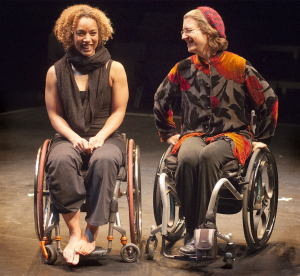
After the event, Alice Sheppard, left, and professor Julia Watts Belser engaged in a question-and-answer session, touching on Sheppard’s experiences as a choreographer.
Dancers often infuse their performances with social and political undertones. This expressive ability was demonstrated by Alice Sheppard during her performance at the Davis Performing Arts Center on Monday night, which intertwined speech and choreography to invoke a unique conversation about the stigma of disability in art.
The piece, titled “Trained to Kill: Reading Disability and Race in Dance,” featured three different sets of choreography, each followed by a short talk by Sheppard. In the talks she discussed a variety of issues ranging from culture to race to the difficulty of receiving recognition as a disabled dancer.
Sheppard, who has been dancing for 10 years, appeared flawless and fluid during Monday night’s performance. In one dance, Sheppard used crutches in addition to her wheelchair as a way to both manipulate movement of her chair and also to produce musical effect, snapping them together to create the effect of percussion instruments.
According to Sheppard, the combination of these two techniques was extremely difficult. It took her two weeks to learn how to move around using both, and much of the inspiration for her movement came from watching YouTube videos of spiders and giraffes. Displaying her athleticism, Sheppard also completed an impressive number of spins and tumbles all while still strapped to her chair.
Sheppard said some people have actually questioned her disability because of her remarkable physical ability. She believes this problem stems from how society typically has one generalized view of the disabled.
“My wheelchair in this world symbolizes the utter failures of my body’s disabilities,” Sheppard said in a question-and-answer session after the show. “However, the thing that is wrong with me is half of what is making my movements possible. … My body does not conform to everyone’s imagination of what disability looks like.”
Before Sheppard began her career as a professional dancer, she received a Ph.D. in medieval studies from Cornell University and worked as an English professor at Pennsylvania State University. Sheppard said her life took a turning point after she saw a performance by disabled dancer Homer Avila. After the show, Sheppard asked Avila, “Does disability dance always have to come from a place of loss or compensation?” In response, Avila told her “No,” and dared her to take a dance class. She hasn’t stopped performing since.
Sheppard has performed with a multitude of dance companies in a variety of countries. She also choreographs a number of pieces for both able-bodied and disabled dancers, though she said she gives preference to the latter.
Sheppard’s performance was sponsored by Georgetown’s newly formed Disability Studies Initiative, a multi-campus interdisciplinary group of students, staff, faculty and community members who are interested in studying the experience of disabled individuals.
According to professor Libbie Rifkin, who is currently serving as the spring coordinator for the Disability Studies Initiative, the initiative hopes to expand its efforts in the near future.
“We would like to broaden the conversation about what disability looks like and the ways in which it is produced and experienced in contemporary culture. We aim to produce accessible events that raise awareness about issues of disability justice at GU and beyond,” Rifkin said after the event. “This semester, our events share a particular focus on disability in the arts.”
For disabled dancers, the plight toward a career in the arts begins way before they even get a chance to see the stage. Even finding a trainer is an ordeal in itself. The number of disabled choreographers is sparse, and nondisabled classes require a great deal of adaptation. Sheppard also said that even dancers who do receive training may still not be given opportunities as a result of the reproach surrounding the work of disabled artists.
“We learn from nondisabled dancers and then invent and reinvent,” Sheppard said. “Too often disabled artists are not given credit for our training.”
However, Sheppard said she hopes her work will continue to shed light on the world of disabled art and dispute stigma surrounding disability art.
“I don’t intend to hide,” Sheppard said. “Performance is an opportunity for the disabled to discover themselves as whole, able. … Just because you can’t do something doesn’t make it disabling.”
Correction: An earlier version of this article misidentified a person in the photo. Sheppard is conversing with professor Julia Watts Belser in the photo.



















